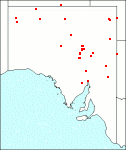Family: Restionaceae
Centrolepis eremica
Citation:
D. Cooke, sp. nov.
Synonymy: Centrolepis polygyna Common name: None
Description:
Annual herb 2-4.5 cm high, forming hemispherical tufts 1.5-6 cm diam., dull-green; leaves numerous, crowded, linear to subulate, obtuse, terete, 4-15 mm long, 0.5-0.7 mm wide, rigid, recurved, glabrous; innermost leaf reduced to an obtuse scarious-hyaline sheath.
Scapes numerous, terete, wiry, 1.5-3 cm long, glabrous; head terete, ovoid-conic, 2-3.5 mm long, 1-2 mm wide; primary bracts opposite, remaining almost closed, with brown cartilaginous bases, the outer bract with a recurved subulate lamina 2-8 mm long, the inner one acute without a lamina; pseudanthia 4-10, all bisexual or some lacking the stamen; secondary bracts absent; female florets 7-20 per pseudanthium; styles connate at the base only.
Seed c. 0.6 mm long.
|
|
Distribution:
|
Usually close to temporary or permanent water, on clay pans, creek beds and lake margins.
S.Aust.: NW, LE, GT, FR, EA, EP. W.Aust.; N.T.; N.S.W.
|
Conservation status:
native
Flowering time: July — Sept.
|

SA Distribution Map based
on current data relating to
specimens held in the
State Herbarium of South Australia
|
Biology:
Related to C. polygyna, which it replaces in central Australia.
Taxonomic notes:
Holotype: Everard Range, S.Aust., A. G. Spooner 73, ix.1968 (AD 96845116). Herba annua glabra caespes hemisphericos compactos ad 6 cm diametro formans, haud purpurascens; folia linearo-subulata tereta ad 15 mm longa recurva apicibus obtusis haud mucronatis; scapi numerosi ad 3 cm longi; capitula ovoideoconica 2-3.5 mm longa 1-2 mm lata, vix aperta; bracteae primariae vaginis cartilaginis brunnels, exterior lamina foliosa 2-8 mm longa; pseudanthia 4-10; bracteae secundariae nullae; ovaria 7-20; styli basi connati; stamen gynophoro discretum interdum absens. The epithet refers to the distribution of the species in the desert region of Australia.
Author:
Not yet available
|

